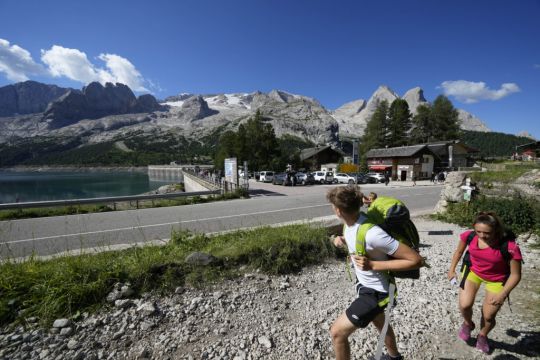Authorities said conditions in the Italian Alps are too unstable for search teams and dogs to work on the mountain where five people remained missing after a fatal weekend avalanche.
Seven people were killed after an enormous chunk of a glacier broke off on Sunday, sending an avalanche of ice and rocks thundering across a trail where hikers were enjoying warm, sunny weather.
Rescuers said they hope the temperature will dip on Thursday, lessening the risk of more avalanches, so searchers could go on the Marmolada slope.
Relatives of the missing Italians pressed for the retrieval of their loved ones’ bodies, which are believed to be buried under the avalanche.

The size of the glacier’s detached pinnacle has been compared to an apartment building.
Trento prosecutor Sandro Raimondi said in an interview on Italian state radio on Wednesday that he has opened a formal investigation to determine if any negligence was involved.
Prosecutors plan to consult geologists.
Mr Raimondi said it appears at this point the avalanche could not have been anticipated.
“The unpredictability in this moment is the chief protagonist,” he said.
Forensic police investigators from the city of Parma have taken samples from some of the remains recovered to try to determine if they belong to any of the people missing.
Meanwhile, the mayors of Canazei and smaller towns at the base of mountains in the Dolomite range issued ordinances closing off the Marmolada peak to hikers.
Some ignored the orders and scrambled up the lower slopes.

Authorities have cited a weeks-long heat wave in northern Italy and scant winter snowfall as likely factors in the weekend breakup of the glacier, which has dramatically shrunk over decades.
Last weekend, the temperature on Marmolada topped 10 degrees Celsius (50 F), unusually high for early summer, authorities said.
Polar science experts at an Italian government-run research centre estimated that the Marmolada glacier could disappear entirely in the next 25-30 years if current climatic trends continue.
Between 2004 and 2015, the glacier lost 30% of its volume and 22% of its area.
People whose livelihoods are entwined with the mountain offered their own observations.
Carlo Budel, manager of an alpine hut on the side of Marmolada, recalled that the glacier was not covered with snow last month.
“Last year, when I moved to the hut on June 1, it took me half a day only to enter because the hut was all covered in snow,” he said.
“But this year, I opened the main door in just 30 minutes.”







